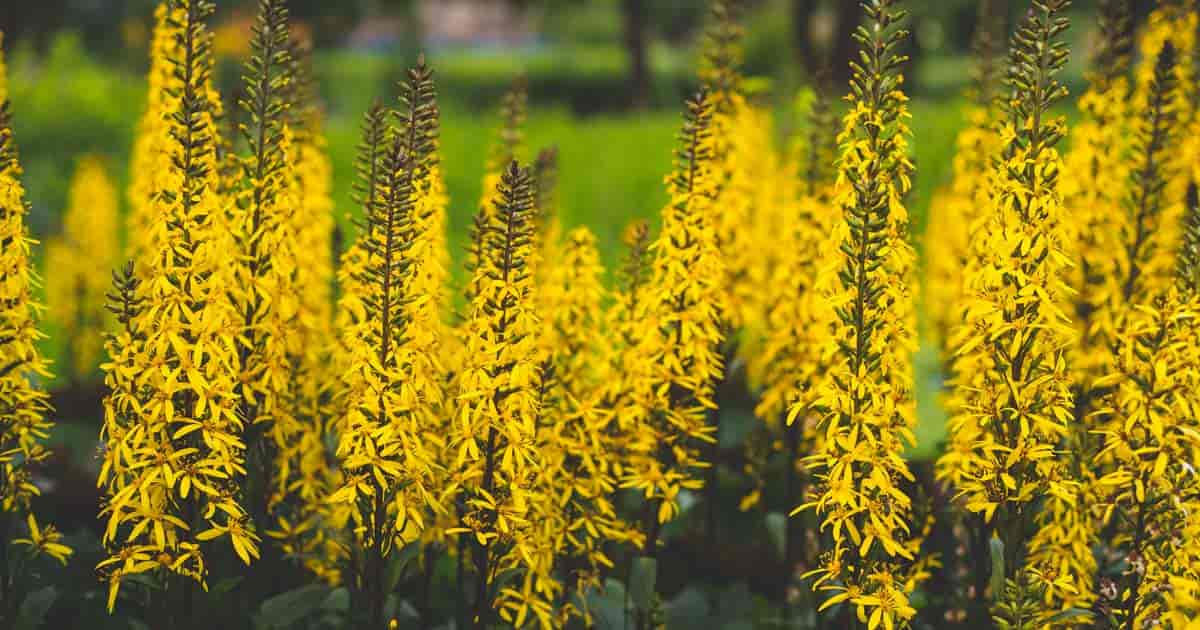Ligularia (Lig-yoo-LAR-ee-uh) Plants belong to the family of Asteraceae and have a variety of different species.
These bold perennial plants are native to Eurasia. They make striking green foliage, and some species like Britt Marie Crawford produces large leaves, making it a splendid addition to the garden.

These plants also add inspires from bright golden or orange flowers for contrast, making a splash in a shade garden.
These plants come in different heights and colors, like Ligularia Dentate and Ligularia Stenocephala, which adds to the garden design even when these plants aren’t in bloom.
The USDA hardiness zones for this plant are 4 – 8.
The common names for Ligularia plants include:
- Rocket Ligularia
- Ragwort flower
- Leopard plants
- Elephant ear
- The rocket
NOTE: Another Ligularia – Ligularia tussilaginea is now known as Farfugium japonicum.
Ligularia Plant Care
Size & Growth
This Ligularia plant grows around 3’ feet in height and spreads around 2’ – 3’ feet as well.
It produces heart-shaped, sharply toothed green leaves.
Due to its vast spread, it creates deep green foliage which creates a beautiful garden design.
Flowering and Fragrance
This plant sports daisy-like, dense, tall racemes of yellow flowers.
The flower spikes are 18” – 24” inches long, and the size of the flowers is 1” wide.
These clusters of flowers are produced in alternate flower spikes and the bloom time is usually during late summer.
Light & Temperature
Ideally, this plant must be placed in partial shade for optimal growth and bloom.
However, it can still grow well in part shade and full sun.
However, when placed in full shade, the burgundy shade of the foliage will start washing out and turning into deep green.
The greens will also be sparser. Unless these plants are in damp soil consistently, there are chances of the leaves wilting almost every day in hot summer conditions.
Watering and Feeding
The Ligularia plant needs constant moisture, which means, it must be planted in moist soil.
During warmer seasons, supplement water must be provided to this plant regularly to stop the leaves from wilting.
Soil & Transplanting
This plant prefers organic, rich soil, and for anything less, it is best to amend the soil with leaf litter or compost.
This plant is particularly adaptive to different pH level ranges, as long as it has fertile soil.
A sufficient amount of mulch should be added to preserve the soil moisture.
Moreover, a handful of peat moss or bone meal may also be used to enhance moisture retention.
Grooming and Maintenance
Aside from the requirement of supplemental watering during the early summer season, these plants need more maintenance.
These plants tend to wilt in the heat, but it is their means of conserving water.
In case the plants don’t regain their full structure even in the cooler conditions, give them more water.
Be sure to water thoroughly since these plants have deeper roots.
Plant Ligularia may be divided during the spring season when the new foliage is emerging, but this isn’t necessary for the best growth.
It is best to add 3” inches of mulch over its crown during the winter when the plant enters its dormancy period.
Ensure the plant is planted in moisture-retentive soil or near water gardens.
How to Propagate Rocket Ligularia
The propagation of this plant type is done through seeds and divisions.
The division must be performed during the early spring.
The seedlings should be directly planted in the garden during the fall or spring season.
Ensure the plants get a sufficient amount of water.
Ragwort Flower Pest or Diseases
The main pest problem experienced by this plant is a snail and slug damage.
It is essential to be on the lookout and take immediate action before severe damage is done.
Moreover, insufficient water also results in damaging the plant.
Watering this plant thoroughly every week is ideal, but it must be increased during warmer conditions.
The damaged and dead leaves must be cut off from the base. It is also a deer-resistant plant.
Leopard Plants Uses
Use Ligularia plants as a waterway display, along with Hosta, Astilbe, Lungwort, Rodgersia, and other types of shade plants.
These plants also look great in woodland or shade gardens and look stunningly planted alongside the pools, ponds, and streams.
